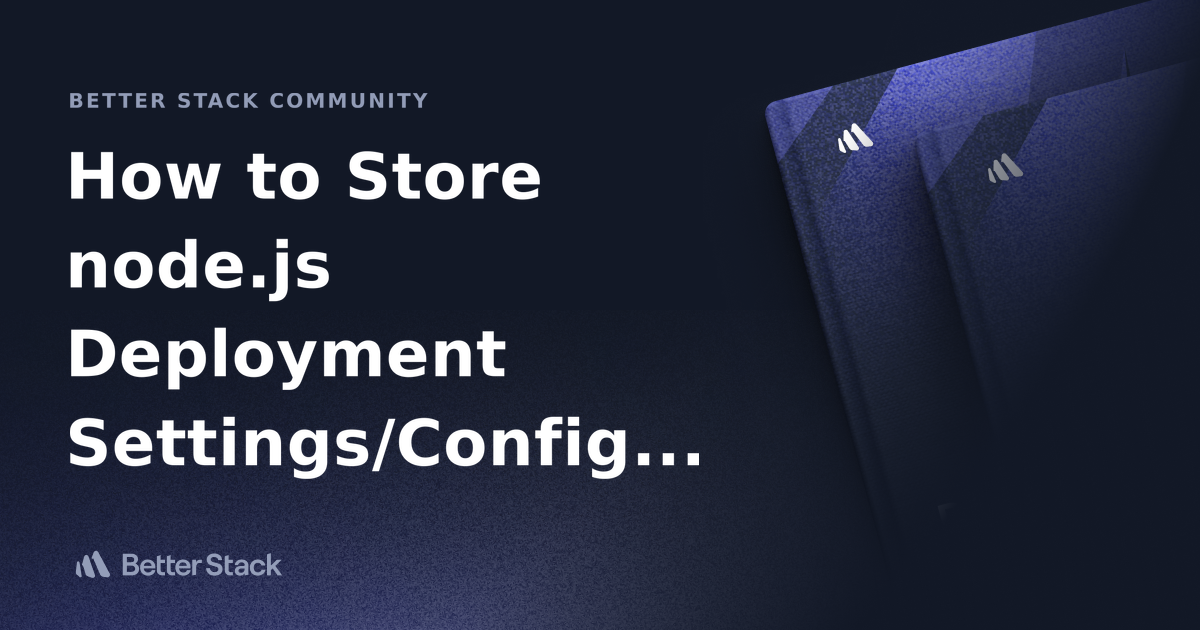Node.js Deployment: Storing Config Files
Explore effective strategies for storing and managing Node.js deployment settings and configuration files to ensure secure and streamlined application deployments.
Explore effective strategies for storing and managing Node.js deployment settings and configuration files to ensure secure and streamlined application deployments.
Effectively managing configuration data is vital for Node.js applications, especially when deploying across various environments. This guide provides a comprehensive, step-by-step approach to handling deployment settings in your Node.js projects, covering different storage methods, environment-specific configurations, and essential security considerations. Whether you're using JSON files, environment variables, or dedicated configuration management tools, this guide equips you with the knowledge to streamline your deployment process and ensure your application operates seamlessly in diverse environments.
Storing and accessing configuration data is crucial for any Node.js application, especially when deploying across different environments. Here's a step-by-step guide incorporating various methods:
1. Choosing a Storage Method:
config folder in your project.development.json, production.json).require function to load the appropriate file based on the environment.const config = require(`./config/${process.env.NODE_ENV}.json`);
console.log(config.databaseUrl);dotenv to load environment variables from a .env file..env file.process.env.require('dotenv').config();
console.log(process.env.DB_HOST);2. Implementing Environment-Specific Configurations:
NODE_ENV environment variable to differentiate between development, production, and other environments.if (process.env.NODE_ENV === 'production') {
// Production-specific configuration
} else {
// Development configuration
}3. Security Considerations:
4. Additional Tips:
By following these steps and considering the available options, you can effectively manage your Node.js deployment settings and ensure your application runs smoothly across different environments.
This code demonstrates various methods for managing Node.js deployment settings across different environments (development, production, etc.). It showcases examples using JSON files, environment variables with the 'dotenv' package, and environment-specific configurations within the application code. The provided examples highlight best practices such as avoiding hardcoding sensitive information and using environment variables or configuration management tools for secrets. Additionally, it emphasizes the importance of using linters, documenting settings, and testing different configurations to ensure proper application functionality.
Following your provided guide, here are some JavaScript examples demonstrating the different methods for managing Node.js deployment settings:
1. JSON Files:
// config/development.json
{
"databaseUrl": "mongodb://localhost:27017/dev_db",
"apiKey": "dev_api_key"
}
// config/production.json
{
"databaseUrl": "mongodb://prod_db_host:27017/prod_db",
"apiKey": "prod_api_key"
}
// app.js
const config = require(`./config/${process.env.NODE_ENV}.json`);
console.log("Database URL:", config.databaseUrl);
console.log("API Key:", config.apiKey);2. Environment Variables with dotenv:
# .env
DB_HOST=localhost
DB_NAME=my_database
API_KEY=secret_api_key
// app.js
require('dotenv').config();
const dbUrl = `mongodb://${process.env.DB_HOST}/${process.env.DB_NAME}`;
console.log("Database URL:", dbUrl);
console.log("API Key:", process.env.API_KEY);
3. Environment-Specific Configurations:
// app.js
if (process.env.NODE_ENV === 'production') {
console.log("Running in production mode.");
// Connect to production database, use production API keys, etc.
} else {
console.log("Running in development mode.");
// Use development settings
}4. Security Considerations:
// Avoid doing this!
const password = "my_secret_password"; Additional Tips:
Remember, choosing the right method depends on your specific needs and the complexity of your application. Consider factors like security, ease of use, and maintainability when making your decision.
While the provided guide covers the essential aspects of managing Node.js deployment settings, here are some additional considerations to enhance your configuration management strategy:
1. Hierarchical Configuration:
config or nconf can help you implement hierarchical configurations effectively.2. Validation and Type Checking:
joi or yup provide robust validation capabilities for your configuration objects.3. Feature Flags:
unleash for advanced feature flag capabilities.4. Secrets Management:
5. Configuration as Code:
6. Automation:
7. Monitoring and Alerting:
By incorporating these additional considerations, you can establish a robust and comprehensive configuration management strategy for your Node.js applications, ensuring optimal performance, security, and flexibility across various deployment environments.
| Method | Description | Example |
|---|---|---|
| JSON files | Store settings in environment-specific JSON files within a config folder. |
config/development.json, config/production.json
|
| Environment Variables | Use tools like dotenv to load settings from a .env file. |
.env file with DB_HOST=localhost
|
| Config Management Tools | Centralized platforms for managing and securing settings (e.g., AWS Parameter Store). | AWS Systems Manager Parameter Store, Azure App Configuration |
Environment-Specific Configurations:
NODE_ENV environment variable to differentiate between environments (e.g., development, production).Security Best Practices:
Additional Recommendations:
By effectively managing your Node.js deployment settings, you ensure your application adapts seamlessly to different environments, promoting smooth operation and scalability. Remember, the chosen method depends on your project's complexity and security requirements. Whether you opt for JSON files, environment variables, or advanced configuration management tools, prioritize security, maintainability, and consistency. Implement best practices like avoiding hardcoded secrets, using linters, documenting settings, and testing configurations to guarantee optimal performance and reliability. As your application evolves, consider incorporating additional strategies like hierarchical configurations, validation, feature flags, and automation to further enhance your deployment process. By mastering configuration management, you empower your Node.js applications to thrive in diverse environments and deliver exceptional user experiences.
 How to Store node.js Deployment Settings/Configuration Files ... | Better Stack lets you see inside any stack, debug any issue, and resolve any incident.
How to Store node.js Deployment Settings/Configuration Files ... | Better Stack lets you see inside any stack, debug any issue, and resolve any incident. Node JS Environment Variables — Setting Node app for multiple ... | Creating and accessing custom .env files to store configirations for your node application to run on different environment modes
Node JS Environment Variables — Setting Node app for multiple ... | Creating and accessing custom .env files to store configirations for your node application to run on different environment modes Configuration File Options - MongoDB Manual v7.0 | path , storage.dbPath , and processManagement.fork . If you modify these settings in the default configuration file, mongod may not start ...
Configuration File Options - MongoDB Manual v7.0 | path , storage.dbPath , and processManagement.fork . If you modify these settings in the default configuration file, mongod may not start ... Node.js Everywhere with Environment Variables! | by John Papa ... | You build your Node.js apps to work first and foremost on your computer. You know it’s important that apps also work everywhere they need…
Node.js Everywhere with Environment Variables! | by John Papa ... | You build your Node.js apps to work first and foremost on your computer. You know it’s important that apps also work everywhere they need… Configuration options - AWS Elastic Beanstalk | The Node.js platform · Procfile · Configuring ... Settings in configuration files are not applied ... configuration files and deploying a new application version.
Configuration options - AWS Elastic Beanstalk | The Node.js platform · Procfile · Configuring ... Settings in configuration files are not applied ... configuration files and deploying a new application version. Configure apps - Azure App Service | Microsoft Learn | Learn to configure common settings for an App Service app. App settings, app config, connection strings, platform, language stack, container, etc.
Configure apps - Azure App Service | Microsoft Learn | Learn to configure common settings for an App Service app. App settings, app config, connection strings, platform, language stack, container, etc.